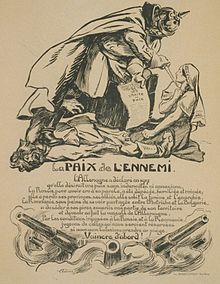Peace of Bucharest (1918)
The Peace of Bucharest of 1918 marks the peace treaty in the First World War between Romania on the one hand and the Central Powers on the other. It was concluded on May 7, 1918 and followed the Focşani armistice of December 9, 1917 and the preliminary peace of Buftea of March 5, 1918. The annulment of the Bucharest Peace was one of the conditions of the armistice between the Central Powers and the Allies of December 11 , 1918 . November 1918.
Most important decisions
- Romania is leaving the war
- End of the German occupation
- South Dobruja and parts of North Dobruja fall to Bulgaria
- The Central Powers receive rights to use the Romanian oil reserves
- Romania renounces some mountain regions and Carpathian passes in favor of Austria-Hungary .
Assignments of territory
After Romania entered the war on the side of the Allies in 1916, the country was defeated by the Four Alliance in the Romanian campaign in 1916/17 . Romania was forced to agree a provisional peace treaty with the Central Powers on March 5, 1918 in Buftea , with which Dobruja was ceded to the Central Powers. This provisional peace treaty was confirmed two months later with the signing of the peace treaty of May 7, 1918 in Bucharest. After that, Bulgaria got the South Dobruja back and part of the North Dobruja. Thus, the old border between Bulgaria and Romania was restored before the Second Balkan War .
After the resignation of Alexandru Averescu as a result of the assignment of territory, Austria-Hungary's original demands were reduced to a fifth in order to accommodate the new Prime Minister Alexandru Marghiloman . Despite detailed definition and an attached map, the lack of accuracy in the survey, especially on the part of the Entente, led to exaggerated speculations about the border correction, which ranged from 5,000 to 15,000 km² and from 20,000 to 130,000 inhabitants. In reality it was about 5,400 km².
The Central Powers built a condominium as a protected area in the rest of the North Dobruja . It stretched north to the southern arm of the Danube Delta . Bulgaria did not agree to the tearing of the Dobruja and demanded that the entire area be incorporated into Bulgarian territory.
After the negotiations on September 25, 1918 in Berlin, a protocol was signed between Germany, Austria-Hungary, the Ottoman Empire and Bulgaria on the cession of North Dobruja to Bulgaria, in which Bulgaria in return undertook to transfer the left bank of the Mariza to the Ottoman Empire To return rich. Thus, for the first and last time, the entire Dobruja was part of the territory of the third Bulgarian state. Only four days later, however, Bulgaria had to capitulate to the Entente , and on September 29, 1918 the Thessaloniki armistice was signed.
The Romanian parliament did not ratify the Bucharest Treaty until the end of the war, but kept postponing the date until the collapse of the Central Powers made it obsolete. As a result of the Paris suburban treaties , the treaty was finally canceled on the side of the Central Powers.
Web links
- Full text of the peace treaty (English)
- Map of the assignments to Austria-Hungary and overall map of the Balkans with the assignments of Romania
Individual evidence
- ↑ Elke Bornemann: The Peace of Bucharest 1918. Frankfurt am Main 1978, ISBN 3-261-01921-2 , pp. 80-83.
- ^ Elke Bornemann: The Peace of Bucharest 1918. Frankfurt am Main 1978, ISBN 3-261-01921-2 , p. 105.



